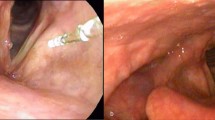Abstract
The leading cause of vocal fold lesions such as nodules and polyps is phonotrauma, which causes microhematoma formation in the vocal fold cover that can initiate an inflammatory process. Vitamin A (Vit A) is essential for immunity, cellular differentiation and maintenance of respiratory epithelium. The aim of this study is to investigate the effect of Vit A (retinyl palmitate) on healing of vocal fold lesions, including vocal polyps and nodules. Eighteen patients with vocal fold lesions were included in the study. Of the patients, 13 had vocal polyps and 5 had vocal nodules. Patients received 90,000 IU oral Vit A in palmitate form daily for 2 months. In addition to Vit A treatment, only vocal hygiene recommendations were given to the patients, without any other medication or specific voice therapy. Pre- and post-treatment acoustic analysis [jitter % (jitt %), shimmer % (shim %), normalized noise energy (NNE), maximum phonation time (MPT), etc.] were performed. Lesion dimensions and stroboscopic findings were evaluated. Voice handicap index (VHI) was applied. Statistical analysis was performed between pre- and post-treatment measurements. Of the 18 patients, 8 had immature lesions (6 polyp-like lesions and 2 immature nodules) and 10 had mature lesion (7 polyps and 3 nodules). None of the patients showed complete healing. Partial response was seen in four patients with immature lesions. There were minimal changes in lesion dimensions, but this difference did not reach statistical significance. MPT of patients with immature lesions were close to significance level but overall MPT revealed no significant improvement (p = 0.051). Jitt %, shim % and NNE did not change significantly. In this study, the only statistically significant finding was VHI of the patients with immature lesions. Three of the patients complained of weight gain. Our data showed that Vit A at a given level of dose and duration seems to be ineffective in the treatment of benign vocal fold lesions. On the other hand, whether Vit A is effective on mature and immature lesions of vocal folds at higher doses and/or longer duration of treatment or not requires further studies.

Similar content being viewed by others
References
Volić SV, Klapan I, Seiwerth S, Ibrahimpasić T (2004) Extracellular matrix of Reinke’s space in some pathological conditions. Acta Otolaryngol 124(4):505–508
Ganguly J (1997) The mode of action and metabolism of vitamin A. In: Bittar EE, Bittar N (eds) Principles of medical biology. Molecular and Cellular Pharmacology, vol 8C. JAI Press Inc, Greenwich, pp 855–869
Blomhoff R, Blomhoff HK (2006) Overview of retinoid metabolism and function. J Neurobiol 66(7):606–630
Sato K, Hirano M (1995) Histologic investigation of the macula flava of the human newborn vocal fold. Ann Otol Rhinol Laryngol 104(7):556–562
Sato K, Umeno H, Nakashima T (2010) Functional histology of the macula flava in the human vocal fold–Part 1: its role in the adult vocal fold. Folia Phoniatr Logop 62(4):178–184
Sato K, Umeno H, Nakashima T (2010) Functional histology of the macula flava in the human vocal fold–Part 2: its role in the growth and development of the vocal fold. Folia Phoniatr Logop 62(6):263–270
Sato K, Hirano M, Nakashima T (2003) Vitamin A-storing stellate cells in the human vocal fold. Acta Otolaryngol 123(1):106–110
Sato K, Hirano M, Nakashima T (2004) Age-related changes in vitamin A-storing stellate cells of human vocal folds. Ann Otol Rhinol Laryngol 113(2):108–112
Sato K, Nakashima T (2009) Stellate cells in the human child vocal fold macula flava. Laryngoscope 119(1):203–210
Sato K, Nakashima T (2005) Vitamin A-storing stellate cells in the human newborn vocal fold. Ann Otol Rhinol Laryngol 114(7):517–524
Gorsky M, Epstein JB (2002) The effect of retinoids on premalignant oral lesions: focus on topical therapy. Cancer 95(6):1258–1264
Ribeiro AS, Salles PR, da Silva TA, Mesquita RA (2010) A review of the nonsurgical treatment of oral leukoplakia. Int J Dent 2010:186018
Issing WJ, Struck R, Naumann A (1996) Long-term follow-up of larynx leukoplakia under treatment with retinyl palmitate. Head Neck 18(6):560–565
Issing WJ, Struck R, Naumann A (1997) Positive impact of retinyl palmitate in leukoplakia of the larynx. Eur Arch Otorhinolaryngol 254(Suppl 1):S105–S109
Kiliç MA, Okur E, Yildirim I et al (2008) Reliability and validity of the Turkish version of the Voice Handicap Index [in Turkish]. Turkish J Ear Nose Throat 18:139–147
Tateya I, Tateya T, Surles RL, Kanehira K, Tanumihardjo S, Bless DM (2008) Vitamin A deficiency causes metaplasia in vocal fold epithelium: a rat study. Ann Otol Rhinol Laryngol 117(2):153–158
Tateya I, Tateya T, Surles RL, Tanumihardjo S, Bless DM (2007) Prenatal vitamin A deficiency causes laryngeal malformation in rats. Ann Otol Rhinol Laryngol 116(10):785–792
Akdogan O, Selcuk A, Ozcan I, Ozcan KM, Giray SG, Dere H, Ozogul C (2009) Activation of vocal fold healing with topical vitamin A in rabbits. Acta Otolaryngol 129(2):220–224
Bichler E, Rauchegger H (1982) Pachydermia of the larynx—treatment with aromatic retinoid (Ro10–9359). HNO 30(8):290–292
Bichler E, Spoendlin H (1979) Pachydermia of the larynx—treatment with the aromatic retinoid (Ro 10–9359). Arch Otorhinolaryngol 225(1):9–14
Alberts DS, Coulthard SW, Meyskens FL Jr (1986) Regression of aggressive laryngeal papillomatosis with 13-cis-retinoic acid (accutane). J Biol Response Mod 5(2):124–128
Rodríguez-Parra MJ, Adrián JA, Casado JC (2011) Comparing voice-therapy and vocal-hygiene treatments in dysphonia using a limited multidimensional evaluation protocol. J Commun Disord 44(6):615–630
Author information
Authors and Affiliations
Corresponding author
Rights and permissions
About this article
Cite this article
Okur, E., Kahveci, O.K., Aycicek, A. et al. The effect of retinyl palmitate on healing of benign vocal fold lesions. Eur Arch Otorhinolaryngol 270, 239–242 (2013). https://doi.org/10.1007/s00405-012-2163-8
Received:
Accepted:
Published:
Issue Date:
DOI: https://doi.org/10.1007/s00405-012-2163-8




